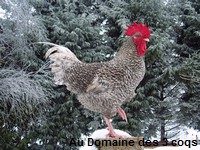 | |
| Conservation status | |
|---|---|
| Other names | |
| Country of origin | Belgium, France |
| Distribution | Flanders, Picardy |
| Traits | |
| Weight | |
| Egg colour | cream-coloured |
| Comb type | single |
| Classification | |
| EE | yes [5] |
| |

The Coucou des Flandres, Dutch : Vlaamse Koekoek, is an endangered Belgian breed of domestic chicken. It may have a common origin with the Malines from the area of Mechelen (French : Malines), in the province of Antwerp in Flanders, or may indeed represent the original type of that breed before it was cross-bred in the nineteenth century with various different types of imported Oriental chicken. By the time of the First World War it had disappeared; it was re-created in the years before the Second World War. It is critically endangered in Belgium, but more numerous in Picardy in France. It may also be known as the Poulet de Dendre, for the Dender river in its area of origin. [3]